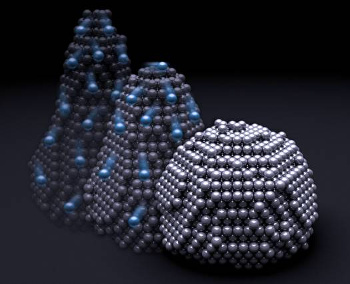
Liquid Nanoparticles
October 24, 2014 As anyone who has tried to pour sand or granulated sugar through a funnel, granular materials will often jam so that their flow is impeded. Non-viscous liquids will flow through a funnel with no problem, but liquids could be considered to be granular, too, although their particles are molecules. It seems that there should be a particle size between molecules and grains of sand at which particles act more like a liquid than a solid. However, the particles, themselves, should still behave as solids, shouldn't they? | Two-dimensional sphere model of granular jamming. The jamming in this case is from formation of an arch, shown by the red spheres. Various factors affect whether jamming will occur, but one factor ignored in this model is a distribution of particle sizes. Small spheres, mixed with the larger spheres, would enhance flow. (Via Wikimedia Commons.) |
 | A representation of atoms comprising silver nanoparticles. (MIT image by Yan Liang.)[2] |
"The interior is crystalline, so the only mobile atoms are the first one or two monolayers... Everywhere except the first two layers is crystalline.”[2]Signs of this same effect have been seen for tin, a metal with a much lower melting point (232 ° C) than silver.[MIT] The particle behavior is pseudoelastic, since the particles return to their former shape when force is removed. The "pseudo-" prefix is added to indicate that the atoms have moved, but the reconstructed shape is unchanged. If the shape were changed, it would be plastic deformation. A similar phenomenon, known as “Coble creep,” was proposed for a similar sort of plasticity by MIT ceramist, Robert L. Coble. The silver nanoparticle behavior is an example of "Coble pseudoelasticity."[1] This effect can be eliminated by an atomically-thick oxide layer. Mechanically, a small grain size promotes fracture toughness, but after a limit, materials get weaker. Says Li, "The transition from ‘smaller is stronger’ to ‘smaller is much weaker’ can be very sharp." This crossover occurs at ten nanometers.[2]
 | Atomic resolution image of a cadmium selenide (CdSe) nanoparticle. The whiter dots are the cadmium atoms, which reflect more electrons since they have a higher atomic number (48) compared with selenium (34). (Electron micrograph by Robert Hovden, via Wikimedia Commons.)[3] |
References:
- Jun Sun, Longbing He, Yu-Chieh Lo, Tao Xu, Hengchang Bi, Litao Sun, Ze Zhang, Scott X. Mao, and Ju Li, "Liquid-like pseudoelasticity of sub-10-nm crystalline silver particles," Nature Materials (Advance Online Publication, October 12, 2014), doi:10.1038/nmat4105.
- David L. Chandler, "Solid nanoparticles can deform like a liquid," MIT Press Release, October 12, 2014.
- Haitao Zhang, Bo Hu, Liangfeng Sun, Robert Hovden, Frank W. Wise, David A. Muller, and Richard D. Robinson, "Surfactant Ligand Removal and Rational Fabrication of Inorganically Connected Quantum Dots," Nano Letters, vol. 11, no. 12 (October 19, 2011), pp 5356-5361.